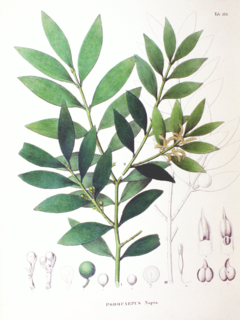- Nageia
-
Nageia 
Nageia nagi Scientific classification Kingdom: Plantae Division: Pinophyta Class: Pinopsida Order: Pinales Family: Podocarpaceae Genus: Nageia
Gaertn.Type species Nageia nagi
( Thunberg) C.E.O. KuntzeSpecies Nageia fleuryi
Nageia formosensis
Nageia maxima
Nageia motleyi
Nageia nagi
Nageia wallichianaNageia is a genus of conifers belonging to the podocarp family Podocarpaceae. [1] Nageia includes evergreen shrubs and trees, from one to 54 meters in height. A 2009 treatment of the genus recognized five species. [2] Some authors consider Nageia formosensis to be a separate species from Nageia nagi, thus recognizing six species. The podocarp genera have been reshuffled by various botanists. Most recently, several species formerly classed as Nageia were moved to the new genus Retrophyllum, while Nageia falcata and Nageia mannii were moved to the new genus Afrocarpus.
The species of Nageia are distinguished from other genera in the Podocarpaceae by their broad, flat sub-opposite leaves with no midrib, superficially similar to those of the unrelated Agathis (Araucariaceae). Nageia is the only genus in Podocarpaceae with multi-veined leaves. The leaves vary from 5–20 cm long and 2–6 cm broad. The cones have several sterile and one (rarely two) fertile scales, each fertile scale with one seed. Unlike Podocarpus, the scales do not become fleshy, but the seed coat develops into a drupe-like fleshy covering 1–2 cm in diameter, which attracts birds, which then disperse the seeds in their droppings.
Nageia can be found in the tropical and subtropical moist broadleaf forests of Asia and Australasia, from Assam in eastern India across Southeast Asia to southern China and southern Japan, and across Malesia, from the Malay peninsula across Indonesia to New Guinea and New Britain. An outpost of N. wallichiana is found in the South Western Ghats montane rain forests of southern India, where it is thought to be a relatively recent colonist in biogeographical terms.
Nageia, like many podocarps, can usually be found scattered throughout the forest mixed with other trees, and is rarely if ever found growing in pure stands. The wood is yellowish, typical of podocarps, and a few species are locally important for lumber.
References
- ^ Christopher N. Page. 1990. "Podocarpaceae" pages 332-346. In: Klaus Kubitzki (general editor); Karl U. Kramer and Peter S. Green (volume editors) The Families and Genera of Vascular Plants volume I. Springer-Verlag: Berlin;Heidelberg, Germany. ISBN 978-0-387-51794-0
- ^ James E. Eckenwalder. 2009. Conifers of the World. Timber Press: Portland, OR, USA. ISBN 978-0-88192-974-4.
External links
Categories:- Podocarpaceae
- Flora of Asia
Wikimedia Foundation. 2010.
